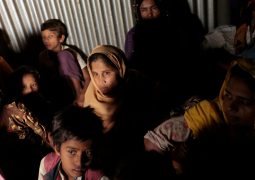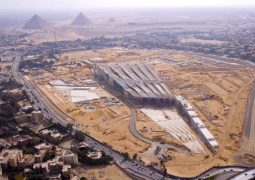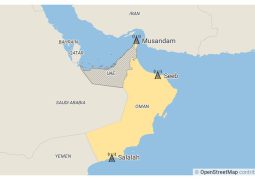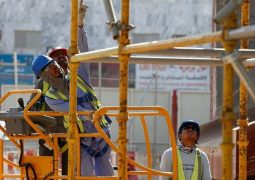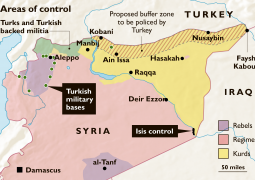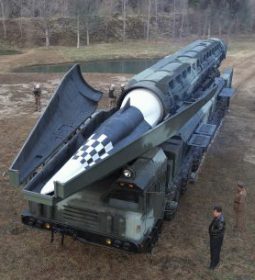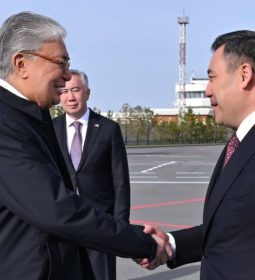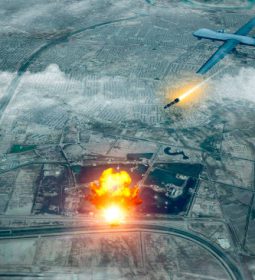India-Pakistan: You can not choose your geography and neighbors: At raid site, no casualties and a mysterious school
Indian bombing inside Pakistani territory appears to have struck a mostly uninhabited forest and a farmer’s wheat field.
By Asad Hashim
Jaba, Pakistan – Indian air raids launched on Pakistani territory earlier this week destroyed parts of a mostly uninhabited forest and a farmer’s field, witnesses and local officials told Al Jazeera, although mystery still surrounds a religious school run by the armed group Jaish-e-Mohammad (JeM) near the bombing site.
Four bombs hit a forest and a field in a remote area outside of the northern Pakistani town of Jaba, about 100km north of the capital, Islamabad, Al Jazeera found on a visit to the site on Wednesday.
Splintered pine trees and rocks were strewn across the blast craters, and there was no evidence of any building debris or casualties. Metal shrapnel from the bombs was visible in four distinct craters.
READ MORE
India-Pakistan tensions: All the latest updates
India claimed on Tuesday to have conducted air raids against a “Jaish-e-Muhammad training camp” in the area, saying “a very large number of JeM terrorists, trainers, senior commanders and groups of jihadis who were being trained for [suicide] action were eliminated.”
Pakistan has denied sustaining any casualties. On Wednesday, Pakistan’s military said its aircraft launched air raids on six locations in the Indian-administered territory of the disputed region of Kashmir.
Local hospital officials and several residents who rushed to the scene said they did not find any bodies or wounded people following the Indian attack, which took place at approximately 3am local time on Tuesday (22:00 GMT).
“I woke up at the sound of the first explosion, and ran out of bed,” said Nooran Shah, 58, a farmer on whose land two of the bombs landed. “The second blast knocWhen Shah went outside to investigate, he said, a piece of shrapnel or a stone struck him on the forehead, wounding him.
Syed Rehman Shah, 50, a neighbour, said he, too, ran from his home when he heard the blasts.
“I heard four loud explosions, separated by a few seconds each,” said Rehman Shah. “It felt like the day of judgement had come.”
Shah said he saw “fire and smoke” as he ran to the aid of his neighbour.
His forehead wounded, Shah fell unconscious. He was later moved to safety and taken to a hospital. The walls of Shah’s home appeared to have cracked and there were several holes in the walls where shrapnel seemed to have hit.
“We are just farmers out here, we grow wheat and maize,” said Rehman Shah. “Some people keep some livestock.”
Mysterious JeM religious school
Following the air raids, India’s foreign ministry said it had hit a training camp run by JeM founder Masood Azhar’s brother-in-law, Yousuf Azhar.
India-Pakistan: Face to Face
Founded in 2000, JeM is an armed group that has launched several high-profile attacks against Indian security and government targets, mostly in the disputed region of Kashmir.
Most recently, JeM claimed a suicide attack that killed at least 42 Indian security forces personnel in the Indian-administered Kashmir town of Pulwama, triggering the latest crisis between nuclear-armed India and Pakistan.
India accuses Pakistan of offering sanctuary to JeM and other armed groups. Following the Pulwama incident, a top Indian military commander said the country had evidence the attack had been “controlled” by Pakistani intelligence.
Pakistan denies the charge and says it has been acting against JeM since banning the group in 2002.
Less than a kilometre to the east of one of the bomb craters, atop a steep ridge, sits a religious school run by JeM, residents told Al Jazeera. A signboard positioned some distance away confirmed the location of the school, and that it was run by the armed group.
The sign for the Madrassa Taleem-ul-Quran lists Masood Azhar as its leader Masood Azhar founded JeM after he was released from Indian custody in exchange for more than 150 hostages after the hijacking of an Indian commercial airliner in 1999. He remains under US sanctions for JeM’s alleged links to the Afghan Taliban.
Yousuf Azhar is wanted by India in connection with the 1999 hijacking.
Al Jazeera was unable to visit the site of the school.
Religious fighters present?
Residents offered conflicting accounts of the facility’s work, with some saying it only offered religious education for local schoolchildren, while others alleged it was a training camp for JeM fighters.
“The madrassa [religious school] there, at the top of the mountain, that is a training camp for mujahideen [religious fighters],” said one resident, gesturing in the direction of the school. He spoke on condition of anonymity given the sensitivity of the subject.
“Everyone here knows there is a Jaish camp there, at the madrassa,” said another 31-year-old local resident, also on condition of anonymity. “It is an active training centre, they teach people how to fight there.”
Others, however, disputed that claim.
“There is no camp here, and no terrorists either,” said Mir Afzal Gulzar, who lives a few kilometres away.
“There was a mujahideen camp here, during the 1980s, but it is gone now,” he said.
There is evidence to suggest the school was an active recruitment centre, if not a training site, for JeM.
In April 2018, Abdul Rauf Asghar – a top JeM commander and Masood Azhar’s brother – addressed a yearly religious gathering at the school, calling upon those present to join the Islamic religious war, according to an article in JeM-affiliated publication Al-Qalam.
A line from the article: “This institution is progressing every day in its aim of providing education, and instruction in religion and jihad.”
Speakers at the event praised the concept of fighting in the name of religion and, according to the article: “offered arguments against certain notions that have been spread against jihad”.
A US Department of Defense memo dated January 31, 2004, leaked by Wikileaks in 2011, indicates the existence of “a [JeM] training camp that offers both basic and advanced terrorist training on explosives and artillery” located near Jaba.
The memo mentions the case of Khalil Rehman Hafez, a Pakistani national and member of JeM who was captured in Afghanistan while fighting US forces and transferred to the Guantanamo Bay prison. Hafez was released and repatriated to Pakistan in 2004.
Back at the bomb site in Jaba, the afternoon sun shines through thick pine forest as local residents gather at Nooran Shah’s house. Some investigate the crater, under the watchful eye of Pakistani soldiers, while others pose for the cameras of local media. In the shadow of the cracked wall of Shah’s house, a defiant group begins to yell patriotic slogans for the cameras. Shah, a slight man clad in a blue shalwar kameez – a traditional tunic with long trousers – and still sporting a white bandage around his forehead, turns to face another interviewer.
Asad Hashim is Al Jazeera’s digital correspondent in Pakistan.
https://www.aljazeera.com/news/2019/02/indian-air-raid-site-casualties-mysterious-madrassa-190227183058957.html
NEW DELHI/SINGAPORE (Reuters) – High-resolution satellite images reviewed by Reuters show that a religious school run by Jaish-e-Mohammad (JeM) in northeastern Pakistan appears to be still standing days after India claimed its warplanes had hit the Islamist group’s training camp on the site and killed a large number of militants.
The images produced by Planet Labs Inc, a San Francisco-based private satellite operator, show at least six buildings on the madrasa site on March 4, six days after the airstrike.
Until now, no high-resolution satellite images were publicly available. But the images from Planet Labs, which show details as small as 72 cm (28 inches), offer a clearer look at the structures the Indian government said it attacked.
The image is virtually unchanged from an April 2018 satellite photo of the facility. There are no discernible holes in the roofs of buildings, no signs of scorching, blown-out walls, displaced trees around the madrasa or other signs of an aerial attack.
The images cast further doubt on statements made over the last eight days by the Indian government of Prime Minister Narendra Modi that the raids, early on Feb. 26, had hit all the intended targets at the madrasa site near Jaba village and the town of Balakot in Pakistan’s Khyber Pakhtunkhwa province.
India’s foreign and defence ministries did not reply to emailed questions sent in the past few days seeking comment on what is shown in the satellite images and whether they undermine its official statements on the airstrikes.
MISSED THE TARGET?
Jeffrey Lewis, director of the East Asia Nonproliferation Project at the Middlebury Institute of International Studies, who has 15 years’ experience in analysing satellite images of weapons sites and systems, confirmed that the high-resolution satellite picture showed the structures in question.
“The high-resolution images don’t show any evidence of bomb damage,” he said. Lewis viewed three other high-resolution Planet Labs pictures of the site taken within hours of the image provided to Reuters.
The Indian government has not publicly disclosed what weapons were used in the strike.
Government sources told Reuters last week that 12 Mirage 2000 jets carrying 1,000 kg (2,200 lbs) bombs carried out the attack. On Tuesday, a defence official said the aircraft used the 2,000-lb Israeli-made SPICE 2000 glide bomb in the strike.
A warhead of that size is meant to destroy hardened targets such as concrete shelters.
Lewis and Dave Schmerler, a senior research associate at the James Martin Center for Nonproliferation studies who also analyses satellite images, said weapons that large would have caused obvious damage to the structures visible in the picture.
“If the strike had been successful, given the information we have about what kind of munitions were used, I would expect to see signs that the buildings had been damaged,” Lewis added. “I just don’t see that here.”
Pakistan has disputed India’s account, saying the operation was a failure that saw Indian jets, under pressure from Pakistani planes, drop their bombs on a largely empty hillside.
“There has been no damage to any infrastructure or human life as a result of Indian incursion,” Major General Asif Ghafoor, the director general of the Pakistan military’s press wing, in a statement to Reuters.
“This has been vindicated by both domestic and international media after visiting the site.”
BOMB CRATERS
In two visits to the Balakot area in Pakistan by Reuters reporters last Tuesday and Thursday, and extensive interviews with people in the surrounding area, there was no evidence found of a destroyed camp or of anyone being killed. [here]
A cropped version of a satellite image shows a close-up of a madrasa near Balakot, Khyber Pakhtunkhwa province, Pakistan, March 4, 2019. Mandatory credit: Planet Labs Inc./Handout via REUTERS
Villagers said there had been a series of huge explosions but the bombs appeared to have landed among trees.
On the wooded slopes above Jaba, they pointed to four craters and some splintered pine trees, but noted little other impact from the blasts that jolted them awake about 3 a.m. on Feb. 26.
“It shook everything,” said Abdur Rasheed, a van driver who works in the area.
He said there weren’t any human casualties: “No one died. Only some pine trees died, they were cut down. A crow also died.”
Mohammad Saddique from Jaba Basic Health Unit and Zia Ul Haq, senior medical officer at Tehsil Headquarters Hospital in Balakot said they had seen no casualties.
POLITICAL FIRE
India must hold a general election by May, and pollsters say Modi and his Hindu nationalist party stand to benefit from his aggressive response to a suicide bomb attack that killed 40 Indian paramilitary police in the disputed Kashmir region on Feb. 14.
North Korea rebuilds part of a missile site
India’s Foreign Secretary Vijay Gokhale said on the day of the strike that “a very large number of Jaish-e-Mohammad terrorists, trainers, senior commanders, and groups of jihadis who were being trained for Fidayeen action were eliminated” in the attack. Fidayeen is a term used to describe Islamist militants on suicide missions.
Another senior government official told reporters on the same day that about 300 militants had been killed. On Sunday the president of the ruling Bharatiya Janata Party (BJP), Amit Shah, put the number killed at more than 250.
The Indian government has not produced evidence that a camp was destroyed or that any militants were killed in the raid.
That has prompted some opposition politicians to push for more details.
“We want to know how many people actually died,” said Mamata Banerjee, the firebrand chief minister of West Bengal state, in a video published by her All India Trinamool Congress party in a tweet on Feb. 28. “Where did the bombs fall? Did they actually fall in the right place?”
Banerjee, who is seen as a potential prime ministerial candidate, said that she stood behind the Indian Armed Forces, but that they should be given a chance to speak the truth.
“We don’t want a war for political reasons, to win an election,” she said.
Modi has accused the opposition Congress party, and other opponents such as Banerjee, of helping India’s enemies by demanding evidence of the attacks.
“At a time when our army is engaged in crushing terrorism, inside the country and outside, there are some people within the country who are trying to break their morale, which is cheering our enemy,” Modi said at an election rally on Sunday.
Additional reporting by Abu Arqam Naqash in BALAKOT; Asif Shahzad and James Mackenzie in ISLAMABAD; Devjyot Ghoshal in New Delhi; Editing by Alex Richardson
- Previous Russian oil imports surge in US as Venezuela’s slow to a trickle
- Next Iran sees “strong support” from Europeans, Russia, China



